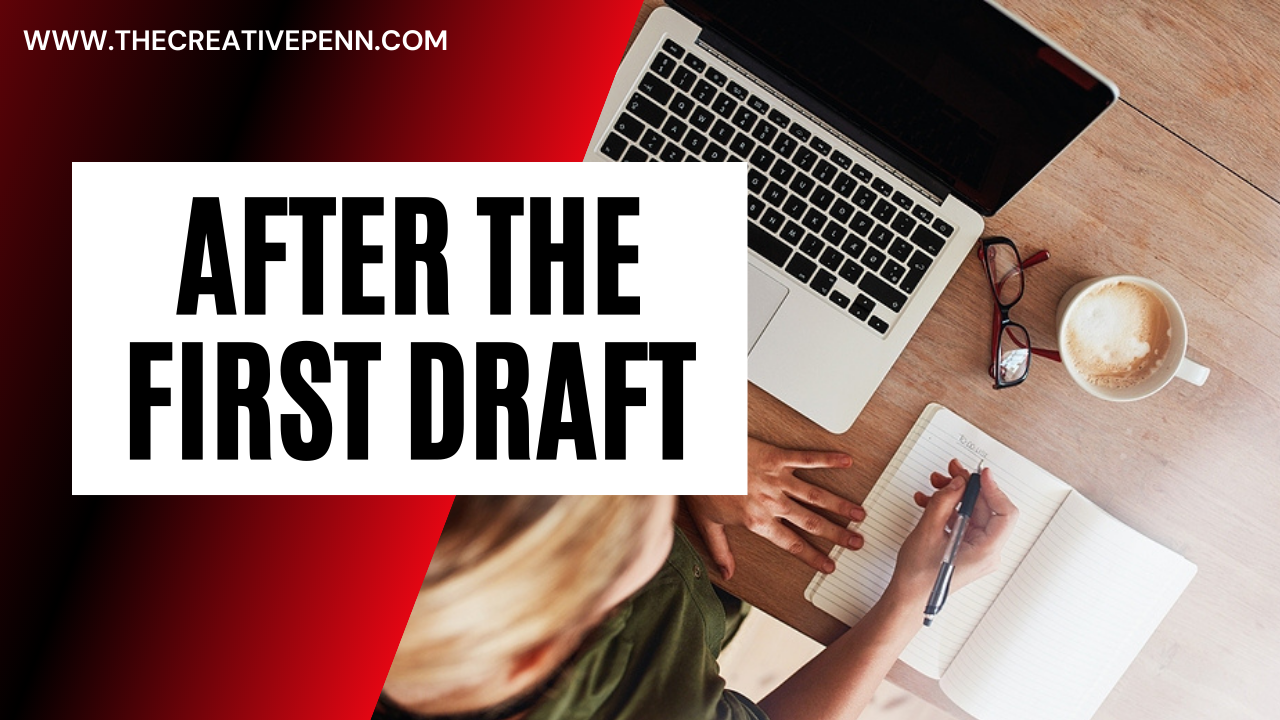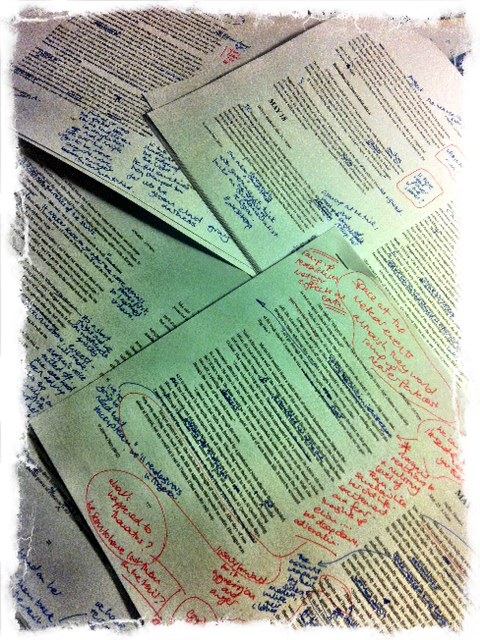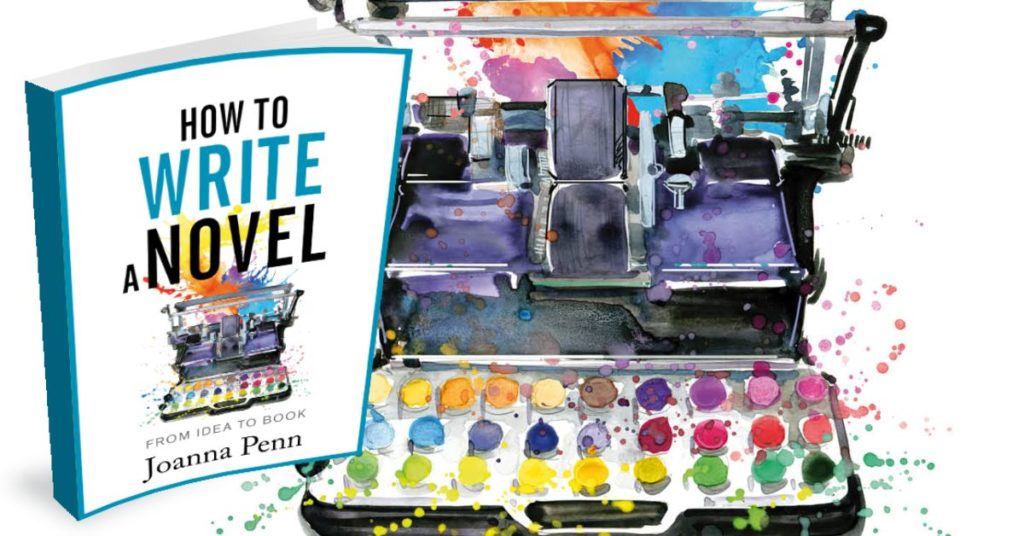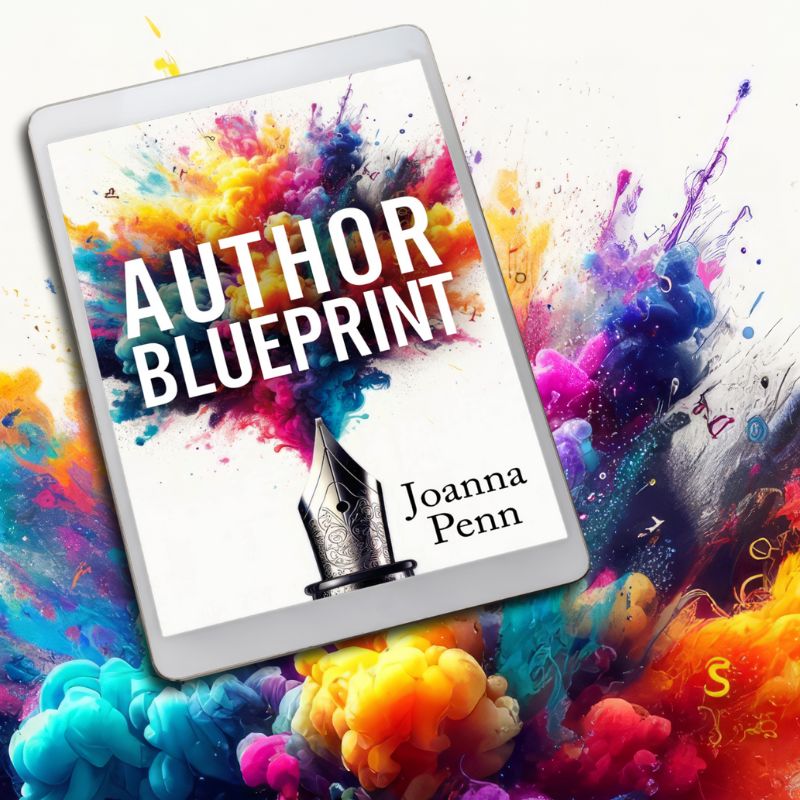Many new writers are confused about what happens after you have managed to get the first draft out of your head and onto the page.
 It is definitely time to celebrate because you have achieved a lot more than most writers! But it's also only the first step towards your finished book.
It is definitely time to celebrate because you have achieved a lot more than most writers! But it's also only the first step towards your finished book.
Here’s my process, and I believe it’s relevant whether you are writing fiction or non-fiction.
(1) Rewriting and redrafting. Repeat until satisfied.
For many writers, the first draft is just the bare bones and often no one will ever see that version of the manuscript. But once those words are down, you can improve on them.

Personally, I love the rewriting and redrafting process. Once I have a first draft I print the whole thing out and do the first pass with handwritten notes. I write all kinds of notes in the margins and scribble and cross things out. I note down new scenes that need writing, continuity issues, problems with characters and much more. That first pass usually takes a while. Then I go back and start a major rewrite based on those notes.
Once I have the first draft in Scrivener, I print the whole thing out and do the first pass by hand. I write all kinds of notes in the margins and scribble and cross things out.
I note down new scenes or chapters that need writing, continuity issues, problems with characters and much more. That first pass usually takes at least a week and is the most substantial edit.

Then I go back to Scrivener and type all my changes into the manuscript, inevitably changing some more things along the way. After that’s done, I will print again and repeat the process, but that usually results in fewer changes.
When I am satisfied that my self-edits are the best I can do, I will send the manuscript to my editor.
Click here to check out my list of recommended editors.
If you are struggling to get to the point of satisfaction with your words and you have been through several self-edits already, or even several pro editors, then read The Pursuit of Perfection and How It Harms Writers by Kristine Kathryn Rusch.
(2) Structural edit / story edit / editorial review
If this is your first book or the first book in a series, it can be worth getting a structural edit (sometimes called a story edit for fiction or an editorial review). This isn't a line by line analysis, but more of an overview on what you can improve.
It's cheaper than a full line by line edit and will help you determine whether you need to do some significant rewrites or re-organization. It's usually presented as a report with sections for the various aspects of the book e.g. problems with characters if fiction, and with chapter order or flow issues when non-fiction.
I had a structural edit for Stone of Fire which was my first novel.
As the other ARKANE novels follow a similar formula, I didn’t get structural edits for the other books in the series.
However, I did get one for the second book in my crime series, Delirium, when I got to a point when I had ‘lost the plot.'
I really didn't know what was wrong with the book, just that something wasn't quite right. I paid for a professional editor to give me a structural edit and she found the problematic scenes. It helped me a great deal and I was able to go back and finish the book.
(3) Revisions
When you get a structural edit back, there are usually lots of revisions to do, possibly even a complete rewrite. It might be hard to go through the report, so I'd recommend setting it aside for a few days while you try to think about it in a non-emotional manner!
The book is yours, so you get to decide whether or not to implement the changes, but remember, you did pay the professional editor to make your finished product better.
If you decide to act on the advice, then go back into the manuscript and make the changes. If they're significant enough, you might need to go through and self-edit again.
(4) Line edits (also known as copy editing)
 This is the classic ‘red ink' edit where an editor goes through your manuscript line by line and marks up issues in spelling, grammar, word choice and any other comments about the book as they go through. This is usually done with Track Changes on a Word document and you get back a version covered in edits.
This is the classic ‘red ink' edit where an editor goes through your manuscript line by line and marks up issues in spelling, grammar, word choice and any other comments about the book as they go through. This is usually done with Track Changes on a Word document and you get back a version covered in edits.
Remember, this is not a structural edit and you will be paying by the word or per 1000 words. So this is the expensive edit and you should make sure the book hangs together well before doing this.
There are horror stories of authors who have paid for line edits on 120,000+ word novels only to decide later that they need to cut the book in half and should have waited to pay for an edit on a tighter 60,000-word manuscript.
You must get the structure of the book right before obsessing over tiny details like word choice or grammar issues.
The first time you get a proper line edit, it will hurt. You think you're a writer and then someone changes practically every sentence. Ouch!
But remember, editing makes your book stronger, and the reader will thank you for it. The more eyes on your book before publication, the better it will be when the book is actually out there. After all, you want a professional product, right?
You can find a list of professional editors here.
You can also use ProWritingAid as an editing tool.
(5) Revisions
You’ll need to make more changes based on the feedback from the line editor. This may be a lot of detailed work when it's your first book, but it gets better with each book if you learn from those edits. After 20+ books, my line edits are pretty clean these days because I have learned from every editing experience so I don't make the same mistakes again.
Make sure you don't just Accept All changes in marked up manuscript, or you won't learn!
It is important to remember that you don’t have to change what the editor suggests and sometimes they will be wrong, e.g. about place names or culturally specific things you know more about. So evaluate each suggestion with a critical eye. I usually end up making about 90% of the changes my line editor suggests.
(6) Beta readers
Beta readers are a trusted group of people who evaluate your book from a reader’s perspective. You should only give them the book if you are happy with it yourself because otherwise, it is disrespectful of their time. Ideally, you also want them to post a review when the book is published, so the closer it is to the finished product, the better.
I use beta readers for specific cultural or knowledge gaps in my fiction, for example, I had an Indian reader go through Destroyer of Worlds to check for issues with my portrayal of India, and I had a Vulcanologist check out Risen Gods for the volcanic scenes.
For non-fiction, I use beta readers to ensure I have covered all the necessary topics in the book as well as any issues with jargon or over-complication.
You can find beta readers from your existing audience, or seek them out in writers groups online.
This could be a critique group, although I prefer a hand-picked group of 5 or 6 who bring different perspectives. I definitely have a couple of people who love the genre I am writing in as they will spot issues within the boundaries of what is expected, and then some people who consider other things.
Some authors use unpaid beta readers instead of professional editors, but I think that the skill of an editor is very different to the experience of reading for pleasure. You need both opinions.
(7) Proofreading
 By this point in the process, you won't be able to see mistakes in your manuscript because you are so familiar with the words! Inevitably, your corrections for line editing will also have exposed more issues, albeit minor ones.
By this point in the process, you won't be able to see mistakes in your manuscript because you are so familiar with the words! Inevitably, your corrections for line editing will also have exposed more issues, albeit minor ones.
So before I publish, I get a final proofread from a fresh pair of eyes.
Proofreading is usually a reasonably priced read-through and final check on typos, grammar and word issues. After Crypt of Bone was published, I even got an email from a reader saying congratulations because they had failed to find a single typo. Some readers really do care, for which I am grateful and that extra investment at the end can definitely pay off in terms of polishing the final product.
Of course, it's important to note that most published books are not error-free, whether they are from big name traditional publishers or small indie micro-publishers. We just have to do the best we can and then let the book out into the world!
(8) Post-publication updates
The beauty of publishing in a digital world is that you can always update your files later. The days of a book being finished on publication are over.
If someone finds a typo, no problem. If you want to update the back matter with your author website and mailing list details, no worries. If you want to re-edit the whole book later when you are a better writer, you can do that too.
This is much easier if you self-publish and control the files yourself. It takes a matter of minutes to re-format on Vellum and then upload those files to the publishing sites.
How long does the editing process take?
Every writer is different, and there are no rules.
But when you're a new writer, your revision process will likely take at least as long as the first draft and probably longer.
As you become a more experienced writer, the revisions and edits might not take so long. Some very experienced writers only write one draft, e.g. Lee Child and Dean Wesley Smith.
How much does professional editing cost?
In terms of money, I would budget between $500 – $3000 depending on what level of editing you’re looking for and how long your book is.
The unfortunate truth is that editing your first novel is likely to be far more expensive than editing for experienced writers because you have so much more to learn. Think of it as an investment in your writing craft and it will get easier (and cheaper) with the more books you write.
I believe editing at all these different stages is important because it is our responsibility to make sure our books are the best they can be. We want to be proud of the finished product.
Happy editing!
For more details, check out How to Write a Novel: From Idea to Book
More resources on editing
Editing, revisions and proofreading: What happens after the first draft?
How to Find and Work With a Professional Editor
My list of recommended editors
Tips for Editing your Book with Natasa Lekic from NY Book Editors
Need more help?
If you'd like some more help on your author journey, check out:
- Free Author Blueprint
- My Books for Authors
- My Courses for Authors
- The Creative Penn Podcast, interviews, inspiration and information on writing, publishing, book marketing and creative entrepreneurship every Monday
- My videos at YouTube.com/thecreativepenn


